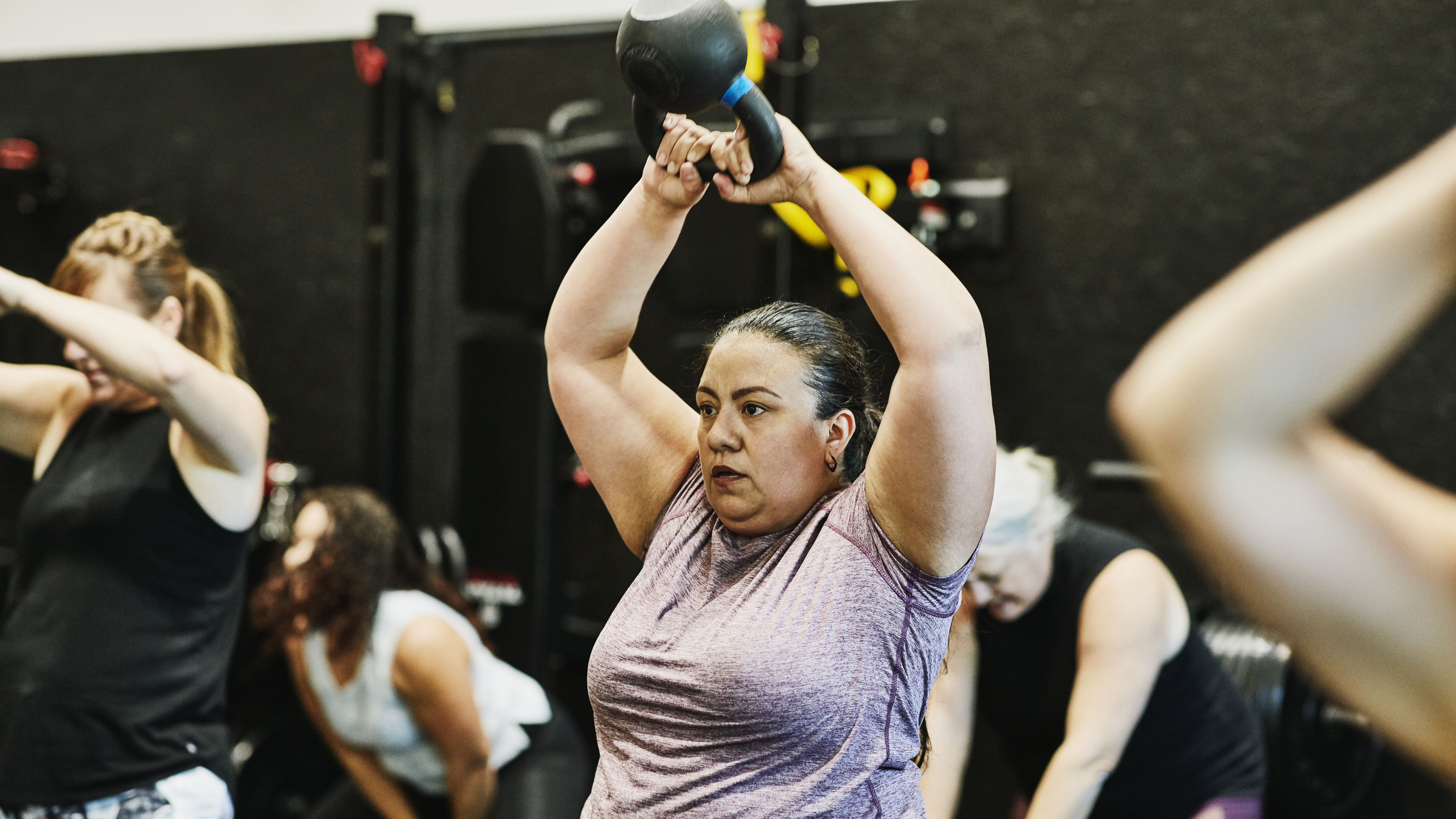What is metabolic conditioning?
What is metabolic conditioning? We combed through the latest research and asked an expert to explain

You may have heard of it before — but what is metabolic conditioning? The term has been around for decades, but it only recently crossed over from the world of elite athletes into everyday gyms. It refers to specific exercises designed to consume the maximum amount of calories in a specific amount of time, so it can help you get the most out of a training session. When it’s done correctly, it can increase lean muscle mass, improve the efficiency of the energy pathways in your body and help with faster weight loss.
To help you understand everything you need to know about this form of training, we spoke to an exercise physiologist and combed through the latest research.
What is metabolic conditioning?

Metabolic conditioning (also called MetCon or metabolic training) focuses on increasing the body’s energy delivery and storage during physical activity.
Our bodies produce energy to fuel physical activity through three different biochemical responses in the body:
- Immediate response (phosphagen pathway): This provides enough fuel to power the body through high-powered activities for less than 30 seconds.
- Intermediate response (glycolytic pathway): This fuels moderate exercise lasting up to 4 minutes.
- Long-term response (oxidative pathway): This gives us enough energy to carry out a low-power activity for several minutes.
Metabolic conditioning focuses on the immediate and intermediate pathways, known as anaerobic exercises. These don’t require oxygen to generate energy. However, they’re too high-intensity for the body to sustain for longer than a few minutes. But by crafting a clever workout program, you can tap into these pathways and make your workout more efficient.
Speaking to Live Science, exercise physiologist and Noom Coach Hope Choplin said. “In its simplest terms, metabolic conditioning is simply a pattern of work versus rest periods used to elicit a response that increases the efficiency of any of these energy systems. The workouts utilize exercise to impact both immediate and intermediate body fueling pathways, by leaning into a specific time and intensity interval to help the body more efficiently use energy.”

Choplin is an ACSM certified clinical exercise physiologist who has a wide range of experience. Based in the UK, she has over ten years' worth of experience creating group exercise programs for people with cardiac and peripheral artery disease. She also has experience in corporate wellness and currently works as a health coach at Noom.
What is the purpose of metabolic conditioning?
“The primary purpose of metabolic conditioning is to help your body become better at producing adenosine triphosphate (ATP). This is the molecule that carries energy around the body”, says Choplin. “Generally moderate- and high-intensity workouts attack these energy systems and improve their efficiency.”

Metabolic conditioning can also prime the body to react more quickly during physical activity.
For example, a 2017 study into male soccer players published in the International Journal of Sports Science and Coaching found that conditioning exercises resulted in players able to jump higher, sprint repeatedly, change direction with the ball and improve their kick. Researchers concluded that conditioning enhanced the performance of players during high-speed soccer-related tasks.
Is metabolic conditioning the same as HIIT?
HIIT stands for high-intensity interval training. Despite the two approaches being very similar, metabolic conditioning forces the body to go all out, using maximum effort. HIIT exercises, on the other hand, look to utilize around 80% of the body’s energy.

The rest periods in between are different too. Whereas HIIT exercises use longer or shorter rest periods depending on the exercises, MetCon rest periods are usually short, around 10 or 20 seconds.
When it comes to exercises used in HIIT and metabolic conditioning, HIIT workouts focus on cardio — for example, running on one of the best treadmills — and exercises that use body weight for resistance. Metabolic conditioning exercises are more likely to encourage the use of weights.
Pros and cons of metabolic training
There are plenty of benefits to metabolic conditioning. It is an efficient use of time, it improves the body's ability to react quickly in sports settings, and it can increase the amount of calories you burn both during and after a gym session. It also increases lean muscle mass and reduces body fat, according to this 2018 study published in PLoS One.
However, there are a handful of drawbacks to the exercise regime too. It could increase the risk of injury, as it requires you to move quickly with weights, and it's not suitable for everyone (such as pregnant people or those with complicated heart conditions.)
It's also quite tricky to pin down the "best" routine, as the exercise regime needs to be tailored to individuals and their fitness levels.

“If you’re unsure of what you’re doing or how to create a routine, this may be a great time to seek the advice of a trainer,” advises Choplin.
Is it good for weight loss?
The particular benefit of metabolic conditioning is that it increases the body’s metabolism and continues to increase it long after exercise. This results in a higher calorie burn post-exercise than many other physical activities, extending the period in which the body is burning fat.
“MetCon workouts can burn tons of calories quickly,” says Choplin. “These workouts have been shown to burn calories, as well as being effective in increasing lean muscle and decreasing body fat, positively altering body composition.”
Many coaches and athletes report a reduction in body fat and studies appear to back this up. For example, a study published in PLoS One in in which researchers put participants through a 16-week HIFT (High-Intensity Functional Training) program similar to CrossFit found that all those who took part had reduced body fat and increased lean muscle mass, with some losing as much as 12.4% of their body fat.
Metabolic conditioning workout for beginners
If you’re looking to include a metabolic conditioning workout into your fitness routine but are unsure where to start, here’s a great short workout from Choplin that requires no equipment. “Always start with a few minutes of warm-up before any workout, such as jogging in place, jumping jacks or torso twists,” advises Choplin.
During the following workout, spend 20 seconds on each activity, followed by 10 seconds of rest.
Circuit 1

Lateral shuffle with ground tap: Engaging the core and keeping the body low in a soft squat position, shuffle from side to side, touching the ground at each side.
Squats: With feet hip-width apart, bend the knees and extend the buttocks backward as if you are sitting in a chair; then rise all the way up to stand.
Repeat these two exercises in a circuit for four rounds (remembering the 10-second break), then take a 60-second rest break.
Circuit 2

Power jacks: Jumping the feet in and out as with regular jumping jacks, alternate between pushing the hands out in front and straight overhead.
Sprint and hold: Bring one knee at a time toward the chest (think high knees), but balance on one foot after every other rep for a “sprint, sprint, hold” pattern.
Repeat these two exercises in a circuit for four rounds (remembering the 10-second break), then take a 60-second rest break.
Circuit 3

Mountain climbers: In plank position, bring alternating knees to chest in a “running” motion.
Push-ups/modified push-ups: Slowly lower the chest towards the ground, keeping the body straight in a plank position. Push up to return to the start. For modification, keep your knees on the floor.
Repeat these two exercises in a circuit for four rounds (remembering the 10-second break), then cool down and stretch.
This article is not meant to offer medical advice and readers should consult their doctor or healthcare professional before adopting any diet or exercise regime.
Sign up for the Live Science daily newsletter now
Get the world’s most fascinating discoveries delivered straight to your inbox.
Joanne Lewsley is a UK-based freelance writer and editor, covering health and lifestyle news and features. She mainly creates evidence-based health and parenting content and has worked with a number of global sites, including BabyCentre UK, Medical News Today, Fit & Well, Top Ten Reviews, and Yahoo!











